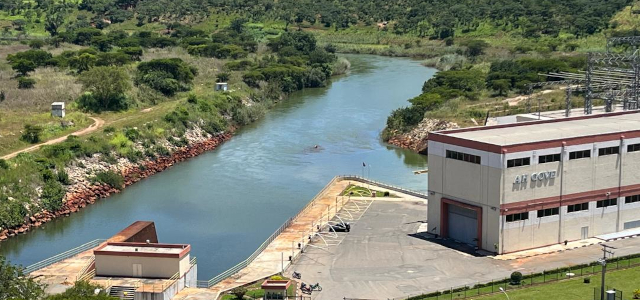The launch of the technical process for developing the three documents was held on 27 March 2025, in Windhoek, Namibia, alongside the workshops for the review of the Cuvelai Basin-wide Integrated Water Resources Management (IWRM) Plan implementation and Consultations on institutional and governance frameworks for the Cuvelai and Kunene Basins on 25 and 26 March respectively. The three-day workshop brought together key stakeholders, including representatives from both governments, regional and international partners, civil society, and indigenous communities.

Stakeholders who attended the launch of the NAP, SAP and NAP development process in Namibia
Speaking during the official opening, Mr. Andrew Takawira, Executive Secretary of GWPSA, underscored the significance of cooperation between the two countries.
“As we strengthen cooperation between Angola and Namibia, we are laying a foundation and building a bridge that will allow generations to benefit from these shared waters, not just as a necessity, but a source of opportunity, prosperity and unity,” said Mr. Takawira.
The Cuvelai and Kunene basins are lifelines for communities in both countries, yet they face rising climate challenges. Last year’s devastating drought, followed by this year’s severe floods, highlighted the urgent need for joint action to build resilience, enhance water governance, and improve livelihoods.
“This technical launch is more than a procedural milestone. It represents our shared ambition to build climate-resilient, inclusive and sustainable transboundary river systems amid the growing uncertainty of climate change. At UNDP, we emphasize strengthening the sustainable management of the Cuvelai and Kunene transboundary river basins to achieve the vision of resilient livelihoods and prosperous communities,” UNDP Namibia’s Ms. Uazamo Kaura echoed the urgency.
Ms. Ndida Nashipili, Deputy Director for Water Basin Management at Namibia’s Ministry of Agriculture, Fisheries, Water and Land Reform (MAFWLR) emphasized the value of inclusivity.
“The transboundary diagnostic analysis is not just a technical exercise; it's a powerful tool for understanding our shared river basins and shaping our collective future. As we embark on this journey for the Cuvelai and Kunene River Basins, let’s make sure we integrate scientific knowledge with indigenous wisdom and listen to indigenous voices who understand the basin best.”
On his part, Mr Octavio Nani, representing the Office for the Administration of the Cunene, Cubango and Cuvelai River Basins (GABHIC) of the Ministry of Energy and Water (MINEA) for Angola, echoed the importance of the TDA as a tool for strategic planning and cooperation. He noted that the workshop was not just a forum for discussion but an opportunity to transform analysis into concrete actions.
“Angola reaffirms its commitment to aligning national priorities with regional objectives, and we are grateful to all international partners for their technical and financial support. We are optimistic and committed to ensuring that this process results in tangible benefits for both urban and rural communities, and for the plans to be actionable and responsive to real needs,” he said.

The Kunene River: A site at the Gove Dam in Angola, with the Gove Hydropower Plant
The TDA-SAP-NAP development process is expected to help the two countries align their national strategies, identify shared challenges and opportunities, and plan joint interventions based on science, policy, and local knowledge. The workshop emphasised the importance of integrating indigenous wisdom and gender-inclusive approaches in water governance.
Dr. Ebenezer Chonguiça,, Regional TDA Expert at GWPSA provided a comprehensive overview of the TDA, SAP, and NAP development process, emphasizing the science-based, participatory, and adaptive nature of the approach. Key points included:
- TDA: Aims to identify and analyze transboundary problems, their impacts, and root causes using existing data, stakeholder consultations, and scientific validation. The TDA process is not about new research but about synthesizing and prioritizing existing knowledge to inform action.
- SAP: Translates the findings of the TDA into a basin-wide vision, goals, and prioritized actions. The SAP is developed through strategic thinking, stakeholder engagement, and alignment with existing plans, ensuring that interventions address the root causes of identified problems.
- NAP: Operationalizes the SAP at the national level, translating basin-wide priorities into country-specific actions, policies, and investment projects. The NAP process is driven by national teams, includes cross-sectoral participation, and is subject to stakeholder consultation, legal adoption, and ongoing monitoring and evaluation.
Discussions further explored the establishment of a joint secretariat to manage both basins more efficiently. Drawing on lessons from the Buzi, Pungwe, and Save basins, participants discussed how a unified administrative structure could streamline operations while retaining basin-specific technical teams.
Workshop outputs included a roadmap for the next phase (2025–2029) of the Cuvelai Integrated Water Resources Management (IWRM) Plan, proposals for governance structures, and commitments to advance inclusive and knowledge-driven planning.
